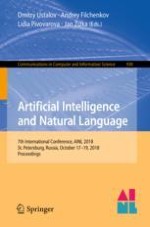
2018 | OriginalPaper | Buchkapitel
Deep Convolutional Networks for Supervised Morpheme Segmentation of Russian Language
verfasst von : Alexey Sorokin, Anastasia Kravtsova
Erschienen in: Artificial Intelligence and Natural Language
Aktivieren Sie unsere intelligente Suche, um passende Fachinhalte oder Patente zu finden.
Wählen Sie Textabschnitte aus um mit Künstlicher Intelligenz passenden Patente zu finden. powered by
Markieren Sie Textabschnitte, um KI-gestützt weitere passende Inhalte zu finden. powered by